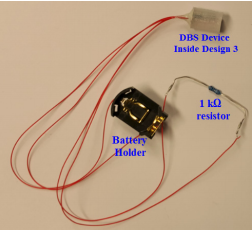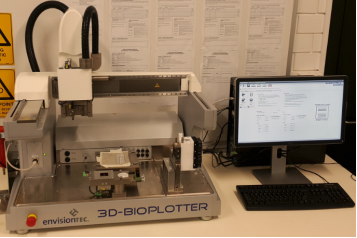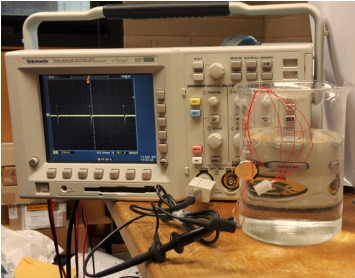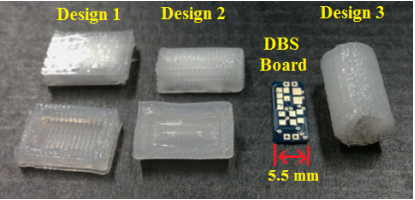Deep brain stimulation (DBS) is a method for treating a variety of neurological disorders such as Multiple Sclerosis and Parkinson’s. In DBS treatment, electrical signals are delivered to a very specific region of the brain through an electrode attached to a microdevice. An area of primary concern in the continued development of these devices for DBS is the manner by which they can be made biocompatible. These devices are made up of components such as wires, a circuit board, resistors and capacitors, and coin-cell batteries and when implanted under the skin, the body recognizes these as non-native, harmful intrusions that should be repelled by its immune system’s defenses.
 There have been a variety of efforts made to create DBS devices that would not be rejected by a patient’s body. The most successful of these methods has involved the creation of a silicone enclosure for the device. Silicone is an excellent material for this type of application because in addition to its inherently biocompatible make up, it is also extremely flexible, elastic, and resilient.
There have been a variety of efforts made to create DBS devices that would not be rejected by a patient’s body. The most successful of these methods has involved the creation of a silicone enclosure for the device. Silicone is an excellent material for this type of application because in addition to its inherently biocompatible make up, it is also extremely flexible, elastic, and resilient.
The difficulty in moving forward with its utilization as the primary method for the containment of DBS devices has been the methods by which it can be applied. The means by which a DBS device can be coated with silicone have been restricted to dipping or molding, although each method comes with its own weaknesses. Dipping the devices to create a silicone coating is a low-cost method for producing a small number of devices but coating formation cannot be sufficiently precisely controlled. Creating molds for the devices offers higher levels of control but also comes with a much higher price tag and the methods by which the molds are created requires a significant investment making it unsuitable for low-volume production.
 In a recent paper published in the proceedings of The International Design Technology Conference held in Geelong, Australia, a team of researchers from Deakin University and the Mayo Clinic presented a novel approach for creating the biocompatible enclosures for these electronic implants. In this paper, the authors proposed that 3D printing the silicone enclosures on a bioplotter could be the most viable method for the creation of implantable DBS devices.
In a recent paper published in the proceedings of The International Design Technology Conference held in Geelong, Australia, a team of researchers from Deakin University and the Mayo Clinic presented a novel approach for creating the biocompatible enclosures for these electronic implants. In this paper, the authors proposed that 3D printing the silicone enclosures on a bioplotter could be the most viable method for the creation of implantable DBS devices.
To test the viability of such an approach, the research team first designed the enclosures using SolidWorks and then sent the models to be printed on an EnvisionTEC GmbH 3D Bioplotter.
In their paper, they described the method by which this printer generates its physical output:
“Multiple materials [can be] inserted using syringes moving in three dimensions. Pressure is applied to the syringes, which then deposit a strand of materials for the length of movement and the time that the pressure is applied. Parallel strands are printed in one layer. For the following layer, the direction of the strands is turned to the centre of the object, creating a mesh with good mechanical properties and mathematically defined porosity. The features of the system include a 3-axis positioning system with high movement accuracy, cell printing with up to five types of cells per object, high flexibility in the choice of materials, fast printing speed, a large build volume, and flexible inner structure design.”
 For their experiments, three enclosure designs, created so as to be printable without the use of support material, were generated and printed in commercial grade silicone. The team then worked to assess the suitability of these enclosures as mechanisms by which DBS devices can be implanted. In order to do this, they were submitted to two tests, one in which they were submersed in water to determine seal quality, and the second in which their performance was monitored while submersed. Both tests demonstrated 3D printing silicone to be a successful method for the creation of DBS enclosures.
For their experiments, three enclosure designs, created so as to be printable without the use of support material, were generated and printed in commercial grade silicone. The team then worked to assess the suitability of these enclosures as mechanisms by which DBS devices can be implanted. In order to do this, they were submitted to two tests, one in which they were submersed in water to determine seal quality, and the second in which their performance was monitored while submersed. Both tests demonstrated 3D printing silicone to be a successful method for the creation of DBS enclosures.
While there is a great deal more testing that needs to be done and more possibilities for refinement of the enclosure design, at the very least these initial experiments demonstrate the enormous potential that this method holds for the creation of biocompatible DBS devices.
You can review the paper here. Join the discussion of this research in the 3D Printed DBS Device Enclosures forum thread over at 3DPB.com.
Subscribe to Our Email Newsletter
Stay up-to-date on all the latest news from the 3D printing industry and receive information and offers from third party vendors.
Print Services
Upload your 3D Models and get them printed quickly and efficiently.
You May Also Like
Consolidation in AM: How 2025 Is Shaping the Industry’s New Normal
The first half of 2025 has been marked by a clear shift in the additive manufacturing (AM) industry. Companies are no longer just focused on developing new tech by themselves....
Etsy Design Rule Change Reduces Selection of 3D Printed Goods
Online marketplace Etsy has implemented a rule change requiring all 3D printed goods on the site to be original designs. The update to the site’s Creativity Standards states, ¨Items produced using...
U.S. Congress Calls Out 3D Printing in Proposal for Commercial Reserve Manufacturing Network
Last week, the U.S. House of Representatives’ Appropriations Committee moved the FY 2026 defense bill forward to the House floor. Included in the legislation is a $131 million proposal for...
Transforming From Tourist to Native: Duro CEO Michael Corr Explains Why the Company Rebuilt its PLM Software on AI
In these early innings of the AI boom, many market analysts have expressed concern that AI spend has gotten too far ahead of the technology’s proven ability to deliver significant...

































